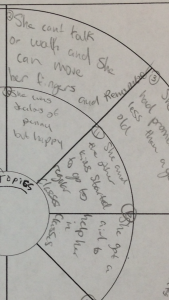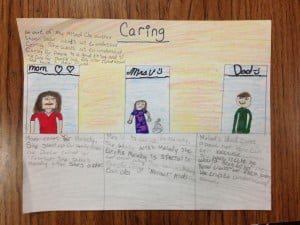 #nablopomo #nablopomoed Blog A Day 21 A great strategy for encouraging learning is…
#nablopomo #nablopomoed Blog A Day 21 A great strategy for encouraging learning is…
collaborative groups. There is one thing I like about the Common Core State Standards. That is that they expect students to work collaboratively to build understanding, share concepts, and use those ideas to develop their own responses. I’ve always thought it sad that with our old standards and their tests, that the students weren’t allowed to discuss and converse about the possibilities and content. Now, it’s supposedly built into the testing format. I don’t have all the details, but this is a good thing.
My students sit in groups [or can quickly arrange themselves so] and have learned about possible roles [ reader, recorder, task master, morale manager, statistician, etc. ] [an old list here ]. Each student has their own writing journal, graphic organizer, or other note manager for their own ideas about the essential question for the reading. Students then share and discuss their individual responses in their groups, and a recorder writes the team’s response to a group question, prompt, or activity on a different organizer. The group sheet / organizer requires a synthesis of the individual responses of the team.
For example, while reading a book as a class, each individual student answered questions for a chapter or group of chapters. Students then discussed and shared their responses. They then determined the key ideas of each question, which the recorder wrote on a different organizer. Finally, the team pulled out the recurring patterns of ideas as “theme topics,” which we later used to develop the theme of the book.
Individuals chose one of the “theme topic” words from the above activity and wrote events and character behaviors that supported that theme topic. As a group, the students discussed their evidence and helped each other write theme statements, with the recorder indicating which theme topics had been covered.
Students now had plenty of vocabulary and content to create their “brosters” [brief posters] with images, evidence, and theme statement. We then placed those brosters into keynote and recorded additional information in text or audio for a theme video. And here’s our theme video.
I’ve mentioned graphic organizers, so I’d like to thank Jim Burke for his amazing resources. Here’s a link to some of those he shares on his blog. My favorites, always available, are the Target and Conversation Roundtable. You’ll see a list of his books on the left — all worth their weight in gold. And do join the English Companion Ning and follow Jim on Twitter. [I really don’t know him to personally call him Jim, but he has truly influenced my teaching and my students’ learning — his work is always there for me to learn more.]
So, a great learning strategy is the use of collaborative groups to understand text, develop content, and create demonstrations of understanding as groups use various graphic organizers to dig into the essential learning together.
What is a learning strategy that helps you or your students?

